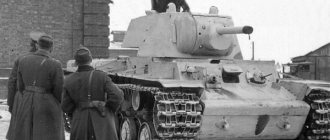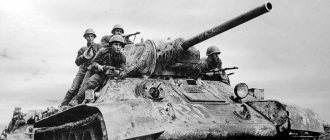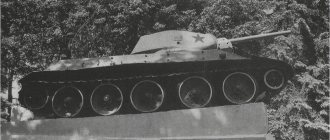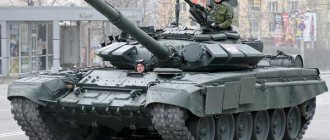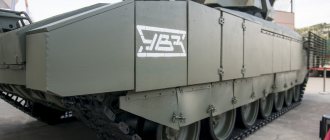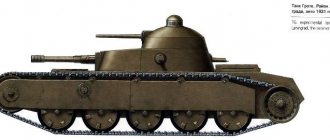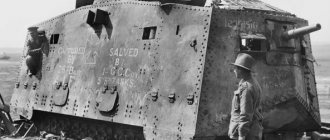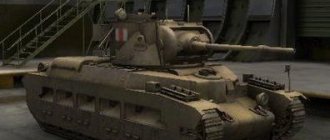Combat use of KV 1
The creation and development of military equipment and weapons is closely related to the military doctrine of the state.
Stalin's point of view is known that a possible war would be fleeting and take place on enemy territory. Accordingly, demands were put forward for the creation of combat vehicles distinguished by their high-speed qualities and the ability to confidently suppress enemy defensive fortifications.
The war at the initial stage, unfortunately, followed a different scenario. Heavy tanks were not defensive. They were used in various types of combat, but, as a rule, not for their main purpose.
But, despite the firepower, reliable armor protection, and heroism shown by the tank crews, heavy tanks, including the KV-1, turned out to be less in demand than medium ones. Heavy tanks suffered heavy losses during this period due to a simple lack of fuel. Without it, the tank is a good target.
Production of heavy vehicles was suspended in 1941. However, already in 1943 the situation changed and the importance of heavy tanks increased again. But without the KV-1.
Heavy tank KV-2.
With the beginning of the Finnish company, a sample of a heavy artillery breakthrough tank was produced. The main purpose of the new tank was high-quality artillery reinforcement of tank units operating in the direction of the breakthrough. Later the tank was given the designation KV-2. This modification reflected the views of the head of ABTU Pavlov. In his opinion, there was a need to arm some medium and heavy tanks with 122-152 mm howitzers or 107 mm TP. Although the project of arming the KV tank with a 122-mm howitzer had previously been worked out, the issue of combating Finnish long-term fortification was a pressing issue.
The only howitzers available with a concrete-piercing projectile in ammunition were the 152nd howitzers. To install an artillery gun of this caliber, the standard one turned out to be too small. Therefore, a group of designers who had previously been involved in installing a 122-mm howitzer in the original turret hastily began designing an enlarged turret for installing a 152-mm howitzer mod. 1938 As a result, even before the end of the Finnish conflict, four tanks went to the front, but they only had the chance to test their weapons against the bunkers abandoned by the enemy.
The road to mass production.
Although the production plan for KV tanks for the fortieth year was approved, significant adjustments had to be made to it. Ambitious plans to create mechanized corps led to an increase in the need for heavy-duty vehicles and, as a result, an increase in government orders for the Kirov plant. According to the new plans, during the third or fourth quarter of the forties, the plant was supposed to produce 230 KV, of which 130 armed with 76-mm TP and 100 with a 152-mm howitzer installed in a large turret.
The government task, even at first glance, exceeded the capabilities for the production of heavy tanks at the Kirov plant, and as a result, preparations began for the production of KV at the production facilities of the Chelyabinsk Tractor Plant. For the production of tanks, where a tank section was hastily organized. In addition, it was decided to simplify the design of the tank, which, without affecting the combat qualities, made it possible to increase their production. SKB-2 was appointed responsible.
The concern was that the KV tank did not undergo a full testing program. Therefore, Deputy People's Commissar of Defense G. Kulik demanded that ABTU carry out a full testing program for the KV heavy tank. As a result, the Defense Committee ordered the required tests to be carried out to detect design defects. Three heavy tanks were allocated for testing. Two of them are with a 152 mm howitzer (KV-2) and one is armed with a 76 mm TP.
The test results were not reassuring. During the testing process, so many defects were identified that the combat effectiveness of the KV-1 tanks began to raise doubts. Especially many defects were identified in the engine and gearbox. Changing gears while moving was accompanied by great difficulties, from the complete inability to change gears to broken teeth. Often, when driving in 4th gear and the adjacent 2nd gear, the gears did not register and “flew out”. To avoid this kind of problem in the future, a special lock was introduced into the design of the gearbox.
In addition to the above, the cooling system had a large number of shortcomings. During prolonged movement, even at a moderate temperature of plus twenty degrees Celsius, the cooling system liquid boiled, which required a reduction in speed or a complete stop. The air filter required frequent cleaning, or even replacement after every hour and a half of movement of the tank in the column.
Other components of the tank were not happy either. For example, the turret rotation mechanism, borrowed from the T-28, had difficulty turning the KV-1 turret, which was four tons heavier. Manually turning the twelve-ton KV-2 turret required excessive effort, which precluded aiming while in motion. And the electric motors of the turning mechanisms often burned out. In general, the tanks were still considered operational, providing the Kirov Plant with a long list of necessary changes that the heavy tank needed.
SKB-2 was unable to cope with so many detected defects, and the technologists did not have time to introduce changes to the production technology. Therefore, KV tanks released in the fall of 1940. were the owners of almost all the shortcomings discovered during the spring tests. The existing situation left representatives of the military acceptance department with nothing else to do but to report in writing to higher organizations about the facts of the delivery of non-combat-ready equipment and the facts of fraud by the director of the Kirov plant, I. Zaltsman. The problems raised in the letters were so serious that they prompted the People's Commissariat of State Control to send a special commission to verify these facts. The work of the commission confirmed these facts and the chairman of the NGK L. Mehlis sent a corresponding appeal addressed to Stalin and Voroshilov.
This letter, like letters like it written by Pavlov, Kulik and others, may have borne fruit, but not immediately. A large number of heavy KV-1 and KV-2 tanks were required to staff the newly formed tank corps, they did not dare to make changes that could reduce production, and remaking finished tanks seemed easier than making changes to the production technology of new ones.
During the production process, it was possible to make changes to the design of the turret's rotating mechanism. A new lowered turret replaced the MT-1 turret for the KV-2 in production. Unfortunately, the transmission and engine of the KV heavy tanks remained unchanged. Just before the end of the year 1940, the Kirov Plant produced:
- 139 KV-1 tanks;
- 104 KV-2 heavy tanks.
Baptism of fire
In the spring of 1942, the formation of separate flamethrower tank battalions began, which were recruited with KV-8s and flamethrower TO-34s. According to the staff, the battalion consisted of 154 people and 21 tanks: 10 KV-8, 9 flamethrower TO-34 and 2 linear T-34. However, in practice, due to the small number of KV-8s manufactured, their actual number could differ from the standard one.
Combat training of flamethrower tank units was carried out according to a specially developed program in Kuzminki, near Moscow, where a special training center was created. In total, in the spring and summer of 1942, 19 separate flamethrower tank battalions were equipped and trained here (from the 500th to the 517th inclusive and the 519th). In addition, by order of the People's Commissar of Defense of the USSR dated September 3, 1941, the 235th separate flamethrower tank brigade was formed in Kuzminki. It was equipped with three flamethrower tank battalions: 506, 508 and 509.
The combat debut of the KV-8 tanks took place during the Sinyavinsk operation of the 8th Army of the Volkhov Front in August 1942. Four flamethrower battalions operated here - 500, 502, 503 and 507, which had 73 tanks, 32 of them KV-8. The latter were in the 500th (10 vehicles), 502nd (10 vehicles) and 507th (12 vehicles) battalions. The 503rd did not have heavy flamethrower tanks, having flamethrower TO-34s.
The battalions were brought into battle on August 27, 1942 in the Gontovaya Lipka - Tortolovo sector. They had about 3-4 days to prepare, during which the commanders carried out reconnaissance of the area and coordinated issues of interaction with infantry, artillery and sappers. At the same time, everyone was involved in reconnaissance of the area, from the battalion commander to the tank driver mechanics.
The terrain in which the attack was to be made was wooded, with many swamps and few roads. At the same time, the swampy areas were separated from each other by narrow sections of land and essentially represented natural defensive lines.
The 500th separate flamethrower tank battalion operated in two groups. The first (3 KV-8 and 2 TO-34) supported the attack of the 11th Infantry Division south of Tortolovo, and the second (7 KV-8, 5 TO-34 and 2 T-34) with the 286th Infantry Division attacked Voronovo. During the attack, one group occupied the first line of German defense without infantry, while “the flames of fire from flamethrowers had a terrifying effect on the enemy, and the Germans, in panic and confusion, rushed into the second line of trenches, suffering losses.”
While moving further, four vehicles were blown up in a German minefield. The crews continued to fire from the spot, but by the evening of August 27, three tanks were set on fire by German artillery.
During the attack of the second group, six vehicles got stuck in the swamp and two were blown up by mines. The remaining 4 KV-8s and 2 T-34s burst into Voronovo, “destroying bunkers, crushing cannon and machine-gun firing points, setting houses on fire, but the infantry did not follow the tanks.” The vehicles returned to their infantry, but they still remained in place. During the repeated attack, 4 KV-8s were hit by artillery, but their crews continued to fire. By the evening of August 27, two KV-8s burned out from artillery shells, and the crews of the other two vehicles defended them for 9 days, firing at enemy positions.
The 502nd Battalion went on the attack at 8:10 a.m. on August 27, 1942, operating in two echelons. In the very first hour of the battle, the tankers drove the Germans out of Tortolovo, but lost 7 vehicles. Continuing to carry out the assigned task, the battalion attacked German positions on the railway embankment, but was unsuccessful: while crossing the Chernaya River, 7 tanks got stuck. At night, the stuck and damaged tanks were evacuated.
During 28 August, the battalion attacked enemy positions three times, but was unsuccessful due to poor infantry and artillery support. As a result, one tank burned down, 2 were hit by artillery fire and 2 got stuck in a swamp.
In the evening, the enemy launched a counterattack with infantry, 10 tanks, and artillery support, trying to drive our units out of Tortolovo. The remaining 4 tanks of the battalion under the command of Political Commissar Klyupkin were immediately moved forward and helped the infantry in repelling the attack with ambush fire. During this battle, 5 German tanks were destroyed.
During the night from August 28 to August 29, 10 vehicles were evacuated and some of them were restored. On August 29, the battalion received the task of capturing the 1st Estonian village together with the infantry. 9 vehicles (3 KV-8 and 6 TO-34) under the command of Major Poborsky took part in the attack. Tanks broke into the village several times, but the infantry did not consolidate their success and retreated during enemy counterattacks.
“The tanks bore the brunt of the battle with the enemy’s fire system and suffered losses in the process. 3 tanks were knocked out by the enemy, 3 tanks were burned, 2 tanks were blown up by mines and 1 tank went missing” (from the “Report on the combat operations of flamethrower tank battalions in the operation of the Volkhov Front for August-September 1942”).
It should be said that the missing tank (it was a KV-8) was captured by the Germans and taken to the rear for study.
On September 1, 1942, a group of six KV-8s from the 502nd battalion and four T-34s from the 503rd participated in the destruction of an enemy stronghold in the area of Berezovaya and Lipovaya Roshcha. Having suppressed some of the firing points, the vehicles reached the railway, but, not supported by either artillery or infantry, retreated to their original positions. In this case, 4 KV-8s were lost.
On August 27, at the signal of an attack, the 507th battalion crossed the Chernaya River and broke into enemy positions, pushing them to the west. Three vehicles were lost during the day. Over the next days, the battalion supported units of the 24th Guards Rifle Division, reaching the eastern shore of Lake Sinyavinskoye. On August 31, the tankers received the task of occupying the defense northwest of Tortolovo. By this time, the battalion had 9 combat-ready tanks left.
In just three days of fighting, the battalions lost more than half of their equipment - 38 tanks. In the report on the hostilities, Fr. Due to heavy losses, by September 11, all tanks remaining in service were reduced to one group, included in the 500th battalion.
The first combat use of flamethrower tank battalions was carefully studied, and at the highest levels. When preparing the reports, unit commanders and tank crew members who participated in those battles were interviewed. Several documents were compiled about the military operations, which were sent to a variety of authorities: the command of the armored forces of the Volkhov Front, GBTU KA, the People's Commissariat of Defense, the People's Commissariat of Tank Industry. It is curious that an engineer from Plant No. 222 (we could not find out his last name) was assigned to the battalions, who was supposed to collect materials on the operation of ATO-41 flamethrowers and design flaws, if any. He prepared his report on the actions of flamethrower tanks by mid-September 1942. In it he wrote in particular:
“...In the 502nd and 503rd separate tank battalions, flamethrower tanks were used in isolated cases, and yet the battalion command and crews highly appreciate the combat effect of the use of flamethrowers. So, for example, the commissioner of the 502nd battalion stated that flamethrowers were used little and rarely due to the fact that the terrain did not allow and the German infantry ran away to distances that did not allow the use of flamethrowers. The application efficiency is good. When firing flames, the enemy runs out of the bunkers, abandoning everything.
The mechanic-driver of the KV-8 tank, Paturnak, says that he fired only 4 shots from a flamethrower. They fired at the tank from an anti-tank gun, but as soon as a shot was fired from a flamethrower in the direction of the anti-tank battery, the crew servicing the gun fled, and two Germans lay down in fear on the ground and were crushed by the tank’s tracks...
The commander of the 507th detachment, Major Nikolaevtsev, says that the KV-8 tank, under the command of political instructor Comrade Osatyuk, fired 15 fire shots at the infantry lying in the bushes. When the flamethrower was used, the infantry fled in panic. Some of the Nazis fled with their clothes on fire. One KV-8 tank used a flamethrower at night. The Germans fled in panic, some of them throwing off their burning uniforms and even underwear.
...The flamethrower is an excellent tool for fighting counterattacking infantry in wooded and swampy areas. Practice has shown that in night conditions the use of flamethrowers has a stunning effect on the enemy.
All flamethrower battalions operating on the Volkhov Front used mainly KV-8 tanks. TO-34 tanks were used very rarely, since, according to the driver mechanics, it was impossible for the driver to drive a tank across a battlefield riddled with craters, overcome engineering obstacles and fire fire.”

